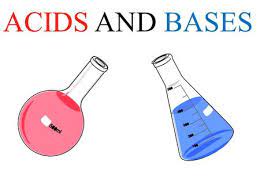Table of Contents

Acids and bases are fundamental concepts in chemistry, representing two opposite ends of the pH scale. These substances exhibit distinct characteristics that set them apart.
Distinctions Between Acids and Bases: In chemistry, the words acid and base are used to distinguish between two significant groups of substances based on their chemical behavior. Chemical compounds can be divided into three categories based on their dissolution: Acids, Bases, and Salts. Acids are chemical substances that serve as proton donors and are clearly identifiable because they contain a releasable H+ ion.
What is an Acid?
An acid can be characterized in a variety of ways, based on chemical theories. An acid, per the Arrhenius definition, is a chemical that when absorbed in water increases the h+. An acid is a chemical that may function as a proton donor, per the Brnsted-Lowry definition.
As a result, the greater the acidity of a chemical, the easier and faster it may be deprotonated. Acids are compounds that can take a pair of electrons, according to Lewis’ definition. Every metal cation, as well as any electron-deficient molecule, can serve as an acid in this instance. The higher an acid’s Lewis acidity, the easier it is for it to receive a pair of electrons.
READ Top Toning Creams in Nigeria
Acids are often found at pH values less than 7. The pH of strong acids is lower. Acids and bases combine to generate salts. They have the ability to convert blue litmus paper to red. They have a sour taste to them as well. (However, strong acids should not be tasted.) Acids include hydrochloric acid (HCl), sulphuric acid (H2SO4), acetic acid (CH3COOH), and others.
What is a Base?
The concepts above can be used to define bases from other perspectives. As a result, an Arrhenius base is a chemical that, when dissolved in water, raises the concentration of OH– ions. A proton acceptor is a chemical that may operate as a Brnsted-Lowry base.
As a result, the higher a compound’s Brnsted-Lowry basicity, the more quickly it takes protons. Bases are substances that has the ability to take two electrons, based on the Lewis definition. The greater a base’s Lewis basicity is, the simpler it is for it to receive a pair of electrons.
Bases are generally found at pH values greater than 7. The pH of strong bases is high. They create salts when they react with acids. They have the ability to change red litmus paper to blue litmus paper. They also have a soapy flavor. (However, powerful bases should not be tasted.) Sodium Hydroxide (NaOH), Calcium Hydroxide (Ca(OH)2), NH3, and other bases are common examples.
Characteristics of Acids and Bases
Acids
a. When eaten, they have a sour flavor.
b. When touched, they might irritate the skin.
c. Metals and skin can be corroded (or eaten away at).
d. Due to the existence of mobile ions, it may be employed as a reactant during electrolysis.
e. Are explored in chemistry and biology
f. They change the universal indicatior red or orange.
Bases
a. They have a bitter flavor, as opposed to a sour taste.
b. Fingers have a slimy or soapy sensation to them.
c. Many bases become salts when they react with acids.
d. Acids and strong bases can react strongly. A modest base can be used to safely neutralize an acid spill.
e. The bases turn red, while the litmus paper turns blue.
f. Bases are metal oxides or hydroxides that contain metals.
g. Alkalis are bases that are soluble in water (soluble bases)
Types of Acids
In water, strong acids completely dissociate ions, whereas weak acids only partially dissociate ions. Strong Acids – A strong acid dissociates ions in water completely. The following are the only six strong acids: HCL (hydrochloric acid), HNO₃ (nitric acid), HBr (hydrobromic acid), HI (hydroiodic acid), HClO₄ (perchloric acid), HClO₃ (chloric acid).
Weak Acids: In water, a weak acid partially dissociates ions. Except for those six acids, the rest of the acids are weak. Hydrofluoric acid is formed when hydrogen and halogen join in a reaction to generate a weak acid, whereas hydrochloric acid is a very strong and incredibly powerful acid that is similarly corrosive in nature, but is classified as a weak acid.
READ Examining Judicial Evidence: Unveiling the 8 Types
Types of Bases
Strong Base: In water or a substance that can take a proton (H+) from a weak acid, it totally separates into its ions. Strong bases include sodium hydroxide (NaOH) and potassium hydroxide (KOH) (KOH).
Weak Bases: In water, these bases completely disintegrate. One of the instances of a base and its conjugate acid is aqueous solution.
Neutral Base: The neutral base is the one that creates a bond with the neutral acid.
Super Base: This sort of base is made up of an alkali metal and its conjugate acid, and it performs even better than a strong base. Sodium hydride is a prime illustration of a super base (NaH).
Solid Base: It can be employed in anion exchange resins or for gaseous acid interactions. It is active in its solid state. Solid base materials include silicon dioxide (SiO2) and sodium hydroxide (NaOH) mounted on alumina.
ALSO READ:
Leave a Reply